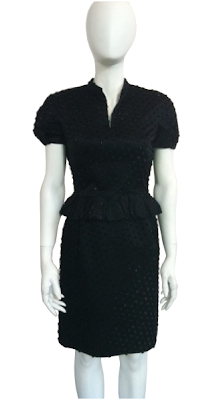
“You can wear black at any time. You can wear it at any age. You may wear it to almost any occasion. A little black frock is essential to a woman’s wardrobe.” ‘Christian Dior’, 1954
A fashion stalwart and sartorial blank canvas, the LBD’s eminent versatility has seen it adapted and reincarnated subject to the popular silhouettes and trends of the time. This exclusive display of LBDs charts the evolution of the iconic garment within one illustrious fashion house – Dior.
Although Coco Chanel is credited as the original 20th century pioneer of the LBD – she wore a slash-necked crepe-de-chine number on the front cover of Vogue in 1926 – Christian Dior resurrected the garment in the post-war years as part of his legendary ‘New Look’ collection of 1947 and it became an integral part of his Maison’s repertoire.
The first dress in the display showcases all the hallmarks of the New Look: the nipped-in, internally boned waist and full skirt reconstructs an hourglass silhouette, while generous quantities of luxurious fabric marks a return to glamour and femininity after years of wartime austerity. Dior’s inspiration here is the notion of woman as a flower, with the delicate, sculpted torso as the stamen poised above many-layered ‘petals’ of skirting.
Next we have a transitional piece from the mid 50s, which still references the New Look silhouette with its neat waistline but simultaneously looks towards the future of slinkier LBDs. Created under license for the wealthy tourist market in North Africa, it was produced for Dior Casablanca.
After Christian Dior’s death in 1957, the 21-year-old Yves Saint Laurent was promoted from Head Assistant to Artistic Director. His first few collections, which retained Dior’s scrupulous attention to detail and perfect proportions yet rendered them lighter and more wearable, saw him feted as a natural and worthy heir to his mentor. This 1959 velvet dress epitomises Saint Laurent’s characteristic dynamism and sculptural approach to tailoring, pairing contrasting textures and an unconventional bandeau bust line.
It’s hard to believe that such creations were not well received, but by the end of the decade Saint Laurent’s designs had supposedly become too daringly avant-garde, influenced by the Beat Look popular in Left Bank cafés and jazz clubs. In late 1960, Dior bosses ousted him in favour of Marc Bohan.
If Dior was the mature designer who led by example and YSL pushed the boundaries, then Bohan was the most commercial. He picked up on the modernist heritage of the label, channelling Dior’s original recipe for style with the exaggerated hourglass silhouette, yet disarticulated this so as to incorporate what the public wanted and reacted to the work of his contemporaries, particularly Balenciaga, Mary Quant and André Courrèges. The dramatic slit neckline and cap sleeves in the final dress in our display show the masterful balance he managed to strike between tradition and modernity.
Three designers, four dresses, ten years of Dior heritage – here is the evolution of a modern classic before our eyes.All dresses are available on Vintage Seekers



















0 comments:
Post a Comment